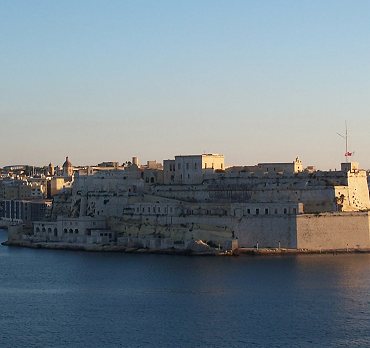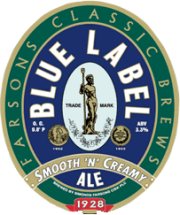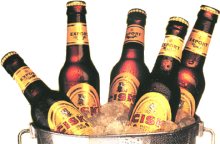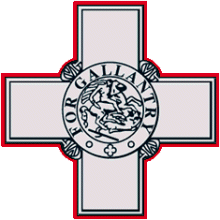 |
 |
|

|
|

|
 |
home
about
Protz
features
A-Z
books
|
|
Protz:
features
reviews
tastings
news & events
books
|

| |
the beers of Malta
by Willard Clarke , 03/2007
The British empire had long and beery tentacles. You fly for three hours and a bit deep into the Mediterranean, glimpse Mount Etna smoking sulphurously on Sicily, then the plane banks and starts its decent to Valletta, the capital city and port of Malta.
Over the centuries, the Phoenicians, Greeks, Carthaginians, Romans, Saracens, Arabs, Normans, Spaniards, Turks and finally Napoleon's France have all invaded the island. All have left indelible marks on the culture
and architecture. The contribution of the British, who ousted Napoleon, was more prosaic - beer.
|
|

|
In the 1880s the large regional brewery H&G; Simonds of Reading established a beer importing business on Malta to supply the island and other parts of the Mediterranean where British troops were stationed. It became a substantial part of Simonds's business, to such an extent that when a Maltese family opened a brewery Simonds decided to join forces and brew on the island.

|
|
The brewery was first known as Farsons, an English-sounding contraction of Farrugia & Sons. In 1928 it became Simonds Farsons and is now called Simonds Farsons Cisk following a merger with the Malta
Export Brewery, whose main lager brand was Cisk, pronounced with a hard C. The name means Czech in Maltese, which gives the beer a good lager heritage, though the brewery was built with help and
guidance from the Augustiner Brewery in Munich and has no Czech connections.
Ale and lager are now brewed on one site, built in 1949 (left). The Farrugia family are architects as well as brewers and chose - rather late in the day - to design the brewery along Art Deco lines. It is a
delight, with tiling and rails in strict Art Deco format, and it has gleaming mash tuns, boiling kettles and hop backs made of copper. The ales were fermented in open squares until 1998 but are now housed in
conical vessels. A Courage yeast culture is used.
|
Simonds became part of the Courage group in the 1960s and its famous Hop Leaf brands disappeared in Britain. They are alive and well on Malta. Hop Leaf pale ale is 3.8% and was joined in 2006 by a stronger version called Hop Leaf Extra (5%). Blue Label (3.3%) was originally a Farrugia brand but was based on the English style known as light mild. Long-retired British servicemen who were stationed on Malta go rheumy-eyed at the mention of Blue Label, once downed in vast quantities.
The fourth ale brand is a delightful oddity - a milk stout. Simonds brewed a version of the style and the Reading influence is evident in Lacto. Milk stout, of which Mackeson is the most famous version, is brewed with the addition of lactose or milk sugar. Lacto at 3.8% is considerably stronger than Mackeson, just 3%. It is Hop Leaf pale ale with the addition of caramel, lactose and vitamin B. It is black/brown in colour, has a pronounced aroma of toffee and figs, with rich dark grain and toffee in the mouth and a finish that becomes dry, with light bitterness and coffee and chocolate notes. It is surprisingly and deliciously refreshing.
It is now a small niche bottled product but is still popular with pregnant and nursing women on Malta and is also used in cooking and Christmas cake. The beer has recently been given a new lease of life as a result of a demand for a keg version from the United States, where milk stout has become something of a cult drink.
|
|

|
Malta cannot provide malt or hops. For the ales, grain is imported from Britain along with Challenger, Fuggles, Goldings and Target hop varieties. Continental ingredients are brought in for the lager brands.
Farsons, like Malta in general, has a constant battle over the lack of water. When Farsons opened its present site, the management deliberately sited it in the Mriehel area of the island because of the presence there of artesian wells. Water also flows down on Roman aqueducts from the exquisite ancient limestone hill town of Mdina. Water supplies are topped up with desalinated seawater and from tanks on the roof that catch the occasional rain.
Blue Label has 25 bitterness units and is brewed with mild ale and crystal malts. It is dark bronze in colour and has a biscuity and nutty aroma, with cobnuts and light hop resins in the mouth and a dry and malty finish with gentle bitterness.
Hop Leaf pale ale has 32 bitterness units and is straw coloured with a light hop resin and biscuity malt aroma. Juicy malt and spicy and peppery hops fill the mouth, with good hop bitterness in the finish balanced by rich malt.
Hop Leaf is a beer of a different colour - deep bronze due to the generous use of crystal malt, which imparts a hint of toffee on the nose alongside hop resins and sappy malt. |
|

|
The palate is bittersweet, with tangy tangerine fruit and peppery
hops. The finish starts bittersweet but becomes dry with spicy hops,
tart fruit and biscuity malt.
These tasting notes are based on bottled versions of the beer. Cisk lagers now account for around 75-78% of Farson's production. Malta has a population of 400,000, roughly equivalent to Liverpool's, but welcomes one million visitors a year, half of whom are British. The brewery has attempted to stop the decline of ale by introducing Hop Leaf Extra and serving the draught versions of its ales in nitrokeg form. As is typical of mixed gas dispense, the beers lack hop character and are bland and sweet.
My advice to anyone visiting Malta is to drink the ales in bottled form, even though they are filtered and pasteurised.
Farsons has set up a British office (www.farsons.com/uk) to sell the bottled beers here. The company is keen to form an alliance with a British brewer to sell draught beer as well. I advised Farsons to test the water with a cask-conditioned version of Hop Leaf Extra at the Great British Beer Festival.
In common with such breweries as Carlsberg and Heineken based in countries with small populations, Farsons needs to break out from its Malta base. The country is now part of the European Union and the open-borders policy means global beer brands are now widely available.
This doesn't mean Farsons is struggling. On the contrary: a new brewery and warehouse complex is being built at Mriehel and will come on stream between 2007 and 2008, boosting production to more than 300,000 hectolitres a year. Mashing and boiling will take place in modern stainless steel vessels. Fortunately, the old Art Deco plant is a listed building and will be retained as a museum, perhaps with an on-site pub.

|
|
The Cisk lagers should not be ignored. They are brewed in different vessels to the ale and undergo a proper Continental double decoction mashing system.
Cisk Lager (4.2%) has a delightful lemon fruit and Hallertau hop aroma, with bitter hops in the mouth, juicy malt and tart fruit, and a dry, bitter and quenching finish.
|
Cisk Export is 5%, is a pale gold colour, with a corn and herbal hop aroma, gentle malt and hops resins in the mouth and a dry finish with rich malt and hops notes. There are also two head-banger Cisk lagers, XS and Red, which weigh in at 9 and 10% respectively, and which are aimed at the Italian market. Sicily is just 70 miles away and there is considerable trade between the two islands.
Malta's cuisine is influenced by the abundance of fish available and also the Italian influence, which is shown in the variety of pasta dishes on offer. Curiously, the major local delicacy is rabbit. Keen though I am to match beer and food I decided not to balance Hop Leaf with boiled bunny.
Malta, incredibly rich in history and multi-faceted culture, is a fine place to visit. There are two seasons: hot and warm. While Britain was dank and gloomy in the depths of winter, I enjoy delightful sunshine and "shirt-sleeve order",
as they say in military circles.
I hope Farsons will succeed in establishing demand for cask beer and can break out of the straitjacket of filtration and mixed gas dispense. That would be the true Simonds' legacy and would mean that Malta GC would stand for Great Cask as well as George Cross.
|
|

|
|
|
home
about
Protz
features
A-Z
books
|





